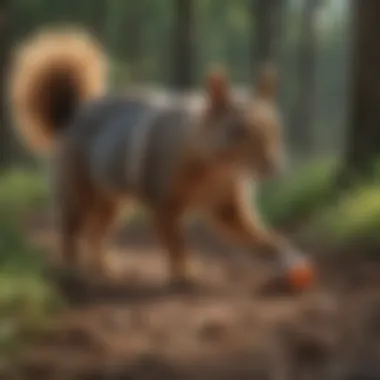Exploring the Safety of Squirrel Poison in Relation to Dogs: A Comprehensive Analysis


Preventive Pest Control Strategies
When it comes to protecting your home from pests, implementing preventive measures is paramount. House exterior protection is a crucial first step in pest control. Begin by carefully sealing any cracks or gaps in the structure of your home to prevent pests from sneaking in unnoticed. Clearing debris around the perimeter of your house also helps eliminate hiding spots for potential intruders. Additionally, focus on preventing pests from entering your home by installing screens on windows and doors.
Yard maintenance plays a significant role in keeping pests at bay. Establish essential yard care routines such as regular mowing, weeding, and pruning to limit pest habitats. Explore methods for keeping your yard pest-free, including the use of natural repellents or barriers to deter unwanted visitors. Taking proactive steps in yard upkeep can significantly reduce the risk of pest infestations.
Indoor cleanliness is another essential aspect of effective pest control. Employ expert cleaning tips and techniques to maintain a hygienic indoor environment that is less inviting to pests. Regular cleaning not only enhances the overall hygiene of your home but also helps in detecting any signs of pest activity early on. Consider implementing pest-resistant materials and keeping food stored securely to minimize the attractiveness of your home to pests.
Proper garbage disposal is not only a sanitation practice but also a critical aspect of pest control. Adopt efficient waste disposal methods such as securing trash cans with tight-fitting lids and disposing of garbage regularly. Understand the importance of proper garbage disposal in preventing pest infestations, as allowing trash to accumulate can attract various pests looking for food sources.
In addition to these fundamental preventive strategies, explore innovative ways to safeguard your home against pests. Consider utilizing natural deterrents like plants with pest-repelling properties or incorporating smart technology for pest monitoring. By integrating a comprehensive approach to pest prevention, you can create a safer and pest-free living environment for you and your family.
Understanding Squirrel Poison
Squirrel poison, though commonly used, poses significant risks to dogs. Understanding the types of poisons available in the market is crucial for pet owners. Anticoagulant Rodenticides are a common type that works by interfering with blood clotting, leading to severe bleeding. Cholecalciferol-Based Poisons contain high levels of Vitamin D, causing toxicity when ingested. On the other hand, Bromethalin-Based Poisons target the nervous system, resulting in neurotoxic effects. Each of these poisons has unique characteristics with varying degrees of effectiveness and safety for pets.
Types of Squirrel Poison
Anticoagulant Rodenticides
Anticoagulant Rodenticides are widely used due to their effectiveness in targeting rodents. However, their mode of action can be detrimental to dogs when ingested. These poisons work by inhibiting Vitamin K, a crucial element in the blood clotting process. As a result, dogs may experience excessive bleeding internally, putting their health at serious risk. While effective in controlling rodent populations, Anticoagulant Rodenticides require cautious handling in households with pets to prevent accidental ingestion that may lead to dire consequences.


Cholecalciferol-Based Poisons
Cholecalciferol-Based Poisons, also known as Vitamin D3 poisons, pose a unique threat to dogs due to their toxic effects on calcium regulation. When ingested, these poisons elevate calcium levels in the body, leading to kidney failure and soft tissue mineralization. The main appeal of Cholecalciferol-Based Poisons lies in their potency against rodents, making them a popular choice for pest control. However, the high toxicity levels also pose a significant risk to dogs, emphasizing the importance of responsible storage and usage to prevent accidental exposures.
Bromethalin-Based Poisons
Bromethalin-Based Poisons target the nervous system, causing neurotoxic effects upon consumption. Unlike anticoagulant and cholecalciferol-based poisons, bromethalin acts rapidly, leading to severe symptoms such as seizures, tremors, and paralysis. While effective in eliminating rodent infestations, the fast-acting nature of Bromethalin-Based Poisons raises concerns regarding accidental ingestion by dogs and other pets. Pet owners must exercise extreme caution when using these poisons to prevent any harmful outcomes.
Mode of Action
Impact on Blood Clotting
The impact of squirrel poisons on blood clotting is a crucial aspect to consider, especially concerning dog safety. Poisons that disrupt blood clotting mechanisms can result in uncontrolled bleeding, creating life-threatening situations for pets. Understanding how these poisons affect the clotting process can help pet owners recognize the symptoms of poisoning early and seek timely veterinary assistance to mitigate the risks. By grasping the mechanisms at play, dog owners can take preventative measures to minimize the chances of exposure to such harmful substances.
Neurological Effects
Moreover, squirrel poisons can induce various neurological effects in dogs, highlighting the need for vigilance and preventive measures. Neurotoxic poisons like Bromethalin can impact the central nervous system, leading to seizures, tremors, and central nervous system depression. Recognizing the signs of neurotoxicity can aid in prompt interventions to protect dogs from further harm. Educating oneself on the potential consequences of these poisons on neurological functions is crucial in safeguarding canine companions from inadvertent poisonings. Constant monitoring and swift response are essential in managing such poisoning cases effectively.
Risks for Dogs
Ingestion Routes


Accidental Consumption
Accidental consumption of squirrel poison is a specific aspect that demands careful consideration within the context of this article. This ingestion route contributes significantly to the overall topic as it underscores the unintentional exposure that dogs may face to toxic substances. The key characteristic of accidental consumption lies in the unforeseen nature of the ingestion, often occurring due to dogs' curious nature or lack of awareness on the part of pet owners. This element is a crucial focus in this article as it highlights the importance of securing poisons away from pets' reach and using pet-friendly alternatives to minimize the risks associated with accidental consumption.
Indirect Exposure
Exploring the realm of indirect exposure to squirrel poison further enriches our understanding of the risks involved for dogs. This ingestion route plays a vital role in the overarching goal of discussing safety measures for pets, as it elucidates how dogs can come into contact with harmful substances indirectly. The key characteristic of indirect exposure lies in the potential for pets to encounter poison through environmental contamination or secondary ingestion. This aspect is beneficial for this article as it underscores the need for dog owners to remain vigilant and proactive in creating a safe living environment for their pets, free from potential sources of poisoning.
Symptoms of Poisoning
Bleeding Disorders
Delving into the realm of symptoms of poisoning, the discussion on bleeding disorders provides essential insights into the potential effects of squirrel poison on dogs. This specific aspect contributes significantly to the overall topic by highlighting the destructive impact of toxins on dogs' blood clotting mechanisms. The key characteristic of bleeding disorders is their potential to lead to life-threatening situations for dogs, emphasizing the severe consequences of toxin exposure. Understanding this aspect is crucial for dog owners to recognize early warning signs and seek prompt veterinary care to mitigate risks and safeguard their pets' health.
Seizures and Tremors
Another critical element to explore within the context of symptoms of poisoning is the manifestation of seizures and tremors in affected dogs. This aspect contributes significantly to the overall narrative by shedding light on the neurological effects of squirrel poison on dogs. The key characteristic of seizures and tremors is their alarming nature, indicating severe poisoning and potential neurological damage in dogs. This information is invaluable for dog owners, prompting them to be vigilant for such symptoms and take immediate action by seeking veterinary assistance to address these critical health issues.
Safety Measures for Dog Owners
Safety Measures for Dog Owners play a crucial role in safeguarding our beloved canine companions. In the context of this article focusing on the safety implications of squirrel poison for dogs, the responsibility falls on dog owners to ensure a secure environment for their pets. By implementing appropriate safety measures, dog owners can significantly reduce the risks associated with accidental poisoning incidents and help protect the well-being of their furry friends. The emphasis on Safety Measures for Dog Owners underscores the essential role that proactive prevention plays in promoting pet health and avoiding potential dangers.


Preventive Actions
Securely Store Poisons
Securely storing poisons is a fundamental aspect of pet safety within households where squirrel poison or other toxic substances may be present. This preventive action involves storing hazardous materials in secure locations that are inaccessible to pets, especially dogs known for their curious and inquisitive nature. By keeping poisons out of reach and locked away in cabinets or high shelves, pet owners can prevent accidental ingestion and exposure, minimizing the risk of poisoning incidents.
Use Pet-Friendly Alternatives
Utilizing pet-friendly alternatives to traditional poisons is a proactive step towards ensuring the safety of dogs in households where pest control is necessary. Pet-friendly alternatives offer a humane and effective way to manage squirrel infestations without posing risks to pets' health. These alternatives typically contain natural ingredients or deterrents that target pests while being safe for pets. By opting for pet-friendly alternatives, dog owners can address pest issues responsibly without endangering their pets' well-being.
Immediate Response Protocol
Contact a Veterinarian
Contacting a veterinarian immediately upon suspecting poisoning in a dog is a critical step in the prompt and effective management of such incidents. Veterinarians possess the expertise to provide guidance on necessary actions, including potential treatment options based on the type of poison ingested. Timely communication with a veterinarian can help in determining the severity of the poisoning and initiating appropriate measures to mitigate harm and facilitate recovery.
Follow First Aid Measures
Following first aid measures recommended for pet poisoning instances is essential in providing immediate care and support to affected dogs. First aid measures may include inducing vomiting (only under veterinary guidance), offering activated charcoal to absorb toxins, and monitoring vital signs. These proactive steps aim to limit the absorption of toxins in the body and alleviate potential symptoms, improving the chances of a successful recovery for the poisoned pet.
Conclusion
In contemplating the safety of squirrel poison concerning dogs, the significance of awareness and proactive measures becomes paramount. As discussed throughout this article, understanding the risks that squirrel poison poses to our canine companions is essential for responsible pet ownership. By grasping the various types of squirrel poisons and their modes of action, dog owners can better appreciate the potential dangers and symptoms associated with poisoning.
Moreover, the delineation of ingestion routes and common symptoms of poisoning provides invaluable insights for dog owners to detect and address any potential incidents promptly. Recognizing the importance of preventive actions, such as securely storing poisons out of reach and opting for pet-friendly alternatives, underscores the proactive role that dog owners can play in safeguarding their pets' well-being.
For instance, when inadvertent exposure occurs, having an immediate response protocol in place - contacting a veterinarian promptly and following recommended first aid measures - can significantly improve outcomes in cases of poisoning. This ensures that prompt and appropriate care is administered to mitigate the effects of the poison, potentially saving a dog's life.
Echoing the sentiment of vigilance and preparedness, this article aims to empower dog owners with the knowledge and tools necessary to protect their beloved pets from the dangers of squirrel poison. By navigating the nuanced landscape of squirrel poison safety with diligence and care, dog owners can create a safer environment for their furry companions, fostering a harmonious coexistence between pets and potentially hazardous substances.



